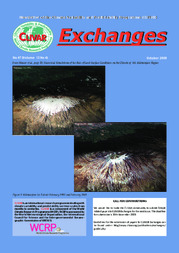Quantifying climate-related risks and uncertainties using Cox regression models.
Quantifying climate-related risks and uncertainties using Cox regression models.
Author(s): MAIA, A. de H. N.; MEINKE, H.
Summary: For applied climate risk management the probability distributions of decision variables such as rainfall, likely dates of climatic events (e.g. frost, onset of the wet season), crop yields or economic returns can be expressed as cumulative distribution functions (CDFs) or probability exceeding functions (PEFs). Such functions are usually derived from empirical or modelled time-series. For forecast purposes in regions impacted by e.g. the El-Nino Southern Oscillation (ENSO), such functions can be categorised by oceanic or atmospheric indexes (e.g. sea surface temperature anomalies, southern oscillation index). These then allow objective climate impact assessments. Although intuition suggests that the degree of uncertainty associated with CDF estimation could impact decision making, quantitative information regarding the uncertainties surrounding these CDFs is rarely provided. Here we propose Coxtype regression models (CRMs) as a powerful statistical framework for making inferences on CDFs in the context of seasonal climate risk assessments. CRMs are semi-parametric approaches especially tailored for modelling CDFs and associated risk measures (relative risks, hazard ratios) and are usually applied to time-to-event data in other domains (e.g. medicine, engineering, social and political sciences). Beyond providing a powerful means to estimate CDFs from empirical data, the Cox approach allows for ranking and selecting multiple potential predictors and quantifying uncertainties surrounding CDF estimates. Well-established and theoretically sound methods for assessing skill and accuracy of Cox-type forecast systems are also available. To demonstrate the power of the Cox approach, we present two examples: (i) estimation of the onset date of the wet season (Cairns, Australia) and (ii) prediction of total wet season rainfall based on historical records (Quixeramobim, Brazil). This study emphasises the methodological aspects of CRMs and does not discuss the merits or otherwise of the ENSO-based predictors. We conclude that CRMs could play an important role in making GCM output more relevant for decision makers through the provision of applicationoriented downscaling techniques.
Publication year: 2008
Types of publication: Journal article
Unit: Embrapa Environment
Keywords: Probabilidade
Observation
Some of Embrapa's publications are published as ePub files. To read them, use or download one of the following free software options to your computer or mobile device. Android: Google Play Books; IOS: iBooks; Windows and Linux: Calibre.
Access other publications
Access the Agricultural Research Database (BDPA) to consult Embrapa's full library collection and records.
Visit Embrapa Bookstore to purchase books and other publications sold by Embrapa.

